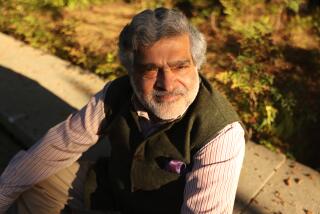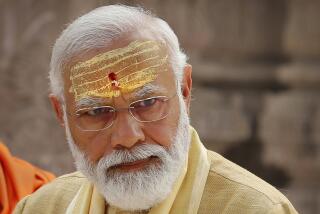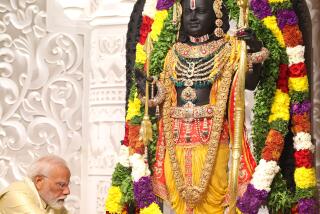Gandhi Says He Hopes for Better Ties to U.S. : Asserts Relations Are Hindered by Weapons Aid to Pakistan and CIA Funding of Afghan Rebels
NEW DELHI — Indian Prime Minister Rajiv Gandhi says he hopes for better relations between India and the United States than existed during the government of his mother, the assassinated Prime Minister Indira Gandhi.
But closer ties are hindered, Gandhi said in interviews with The Times, mainly by the continued U.S. supply of weapons to Pakistan, India’s traditional rival and enemy in three conflicts.
“I think it (the future of U.S.-India relations) very much depends on U.S. policy. We have an open mind, but there have always been problems with the arming of Pakistan. We see these weapons as ultimately being used against us. This worries us. This is the biggest problem we have with the United States in our region.
“We want to live in peace with all of our neighbors,” he went on. “We can’t afford to spend too much on weapons. So far, we have kept our spending to a little more than 3% of our gross national product. This is much lower than most other countries. We feel that we are very balanced (in foreign relations) and that we have not taken sides in the world. We try to judge each case on its own merit.”
Moreover, the 40-year-old prime minister added, he is worried by reports of increased CIA financing of Afghan rebels based in Pakistan. “And really, it gives an excuse for the Soviet troops to be there (inside Afghanistan),” he said.
There have been reports that the CIA is spending more than $200 million to supply the rebels, and Gandhi remarked: “This is the highest they have spent anywhere since Vietnam. That is worrying us as well as the weapons in Pakistan.”
Asked if India favors the Soviet position, he said, “We don’t like any intervention by any country in any other country. And that goes equally for both major powers, and for smaller powers.”
In the interviews, his first with a Western newspaper since becoming prime minister in October after Indira Gandhi’s assassination, the soft-spoken leader balanced his criticisms of the Soviet Union and the United States.
For example, he said he is encouraged by the decision of the New Zealand government to ban port visits by U.S. warships capable of carrying nuclear weapons. However, he said he does not think that such actions should only be taken against the United States.
“More countries should take a stand against both blocs--not targeting only one or even the two superpowers. Great Britain, France and China also have the weapons,” Gandhi said.
“What is getting more and more dangerous now is this talk of a limited or controlled nuclear war,” he continued. “This is a highly dangerous concept because I don’t think that any such war, once started, can be controlled.”
Wants ‘Both Sides to Lay Off’
Regarding the conflict between the United States and the Soviet Union over the presence of Soviet troops in Afghanistan, Gandhi said, “We want both sides to lay off, to put it bluntly.”
The prime minister also said that India will not resume its program of developing nuclear weapons, even if Pakistan makes its own bomb.
“It is very difficult to foresee every situation,” he said, “but at the moment I don’t see a situation arising where we would start up again making the bomb. Just the fact that Pakistan made a bomb would not make us change our policies.
“We don’t want to become the same as the others. That would only make the situation worse, not better. It would make us no different than the others who are making a bomb, whom we are trying to talk out of making a bomb.”
The picture of Gandhi that emerged--after a reporter traveled with him on a two-day election campaign trip through four Indian states and 25 cities--was that of a leader who seems more objective and open-minded, less strident and polemical, than was his mother, who governed the country for almost 16 of the last 18 years. The interviews took place during the trip.
In the two days of strenuous campaigning, aimed at winning control of state legislatures for his ruling Congress-I Party, Gandhi appeared before wildly enthusiastic crowds in the cities as well as in tiny tribal hamlets. The crowds, the largest of which numbered about 200,000, were estimated to total more than 2 million people.
A veteran journalist, P.P. Pande, who often accompanies the prime minister, stressed the importance of these turnouts, saying: “During the parliamentary campaign (in December), people said the crowds were coming just to see the new man or because of sorrow over his mother. Now they are coming to see him. They are his crowds.”
Security men say the crowds contain many more women and young men than before. There are also fewer pictures of Indira Gandhi adorning the speaker’s platforms than during the parliamentary elections.
In nearly every city and town on the campaign tour, it was the same. The prime minister’s Soviet-made helicopter would descend on the town, where a landing pad of dirt and cow dung had been wet down minutes before.
As the townspeople spotted the helicopter, they capered with delight. Ribbons of people wearing clothes of white khadi cloth could be seen streaming--often running--to the meeting place. They threw marigold garlands at their leader and chanted a rhyming refrain in Hindi to welcome him.
At each location, Gandhi would quickly jog up the steps of the speaker’s platform and, in his quiet, almost shy way, begin talking to the crowd about subjects that ranged from education for women to the horrors of “nuclear winter.”
“He has a unique way of speaking. It is more like a chat with the people,” said Gandhi aide Arun Singh, who along with others close to the prime minister has watched him emerge as an effective public speaker. On this trip, Gandhi did not harangue or engage in the polemics and mild xenophobia that often marked his mother’s speeches.
No Mention of U.S.
He seldom mentioned Pakistan and never mentioned the United States or the Soviet Union except in the context of nuclear disarmament. The most common theme of his campaign, which political pollsters predict will give his party an even firmer grip on the nation, was rooting out the corruption that flourished in previous Congress-I administrations.
Gandhi’s anti-corruption campaign has been the boldest of his efforts since his landslide election victory two months ago.
During the parliamentary campaigning, he dropped many incumbent Congress-I candidates who had served under his mother. Now, for the March 2 and 5 state assembly elections in 11 key states, Gandhi and his young advisers have cut hundreds of Congress-I incumbents, including dozens of state ministers, from the party slates.
In an informal discussion over dinner in the private compartment of his Boeing 737 aircraft, Gandhi described the anti-corruption effort as an agonizing and dangerous move. To purge the rolls of candidates he felt had been corrupt or ineffective meant eliminating many longtime professional politicians, including many who had been strong allies of Indira Gandhi’s.
“The system over the years has slowly deteriorated,” Gandhi said. “And the corruption sort of inched itself in at all levels--everywhere.”
Gandhi likened the purge of party regulars to a similar effort led by Indira Gandhi in 1969 when the ruling party split into rival factions. He added that corruption was a problem that had existed back to the times of his grandfather, India’s first prime minister, Jawaharlal Nehru.
Several candidates whom Gandhi has dropped have formed rebel slates for office, and among older politicians there is widespread anger.
Gandhi admitted that the corruption drive may give him long-term political problems as it alienates party regulars. But the prime minister, a former airline pilot who had no such ambitions before he was thrust into public life by the death of his more politically oriented brother, Sanjay, in 1980, said there is no point in being prime minister unless the corruption and inefficiences of the government can be eliminated.
In the past, the corruption has ranged from outright bribery, including payments to obtain government action, to schemes of mass political defection from one party to another in exchange for enormous sums of money.
The Congress-I Party of Indira Gandhi was the principal political beneficiary of these defection schemes--often using them to topple opposition state governments. Rajiv Gandhi, however, contends that the constant turmoil in state governments ultimately hurt his party.
“We lost credibility and we lost cohesion within the party,” he said.
In the recent session of the new Lok Sabha (the lawmaking lower house of Parliament) Gandhi succeeded in passing a constitutional amendment barring legislators from switching parties during a term.
“We said we would clean up the body politic,” Gandhi said in a speech in the small Madhya Pradesh village of Akodia. “We have taken the first steps and have put an end to one of the major problems--defections. Defections allowed groups of people to weaken the fundamental structure of politics.”
His statements were greeted warmly by the people of Akodia, a wheat-producing town of 7,000 people. There, 60,000 showed up to hear Gandhi speak.
In the Rajasthan city of Vallabhnagar, a young U.S.-educated professor of philosophy, inspired by Gandhi’s clean image, is running for a state assembly seat on the Congress-I ticket.
“He (Rajiv) is an example of what I tell my students,” said Girija Nyas. “Even politics can be in accordance with moral philosophy.”
Jokes With Crowd
Watching from behind the stage in the city of Bardoli as Gandhi joked gently with the crowd about the opposition party’s poor showings in the parliamentary elections, Gujarat state’s chief minister, Madhabsinh Solanki, a wily veteran politician and former journalist, praised Gandhi’s party cleanup. Solanki had seen several of his own party men dismissed in the cleanup purge.
“I had reservations about some of them,” he said. “But overall, the stock of the Congress Party has been increased. His cleansing operation has inspired the people. There are more women and young people. The new Mr. Clean image of Rajiv Gandhi has captured the imagination of young people.”
More to Read
Sign up for Essential California
The most important California stories and recommendations in your inbox every morning.
You may occasionally receive promotional content from the Los Angeles Times.










